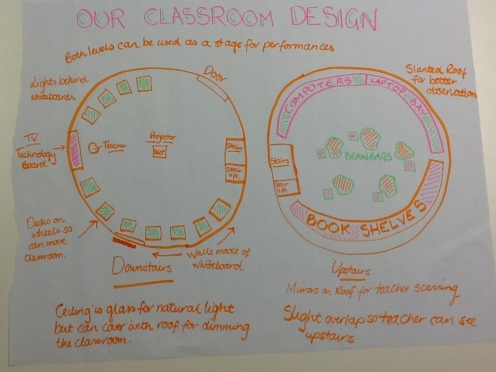Archive for July, 2013
Preservice students’ ultimate classroom design
Posted by kmcg2375 in education, university on July 29, 2013
In most English Curriculum units I run an activity where students work in groups to design their ultimate English classroom.
Here are some of the elements that come up in many of the designs:
- Really big bookshelf
- Reading area/chill out zone with bean bags
- Lots of windows
- Blackout curtains around the room for cinema viewing & drama background
- ‘Drama blocks’ that can be used as seating or a stage (or a dedicated stage area)
- An indoor plant
- Projector and screen
- Moveable tables (though note often teacher-centric as default)
Some groups, but not too many, also include:
- Interactive whiteboard/s
- Posters on the wall
- iPad/laptop chargers
- Student work display board
- Different ‘zones’ in one big room
- Coffee/tea making area
- An outdoor area e.g. verandah
The inclusion of a coffee/tea area is slightly worrying, given the adolescent age range of the students in mind!
Other than that though, I can see very good reasons for most of these design elements.
The only problems is…I know that these aspiring teachers have buckleys of fitting all this in to a traditional school classroom space. Until we knock down the walls and invest in new, flexible, comfortable furnishings, these dream rooms will stay just that. A dream.
What do you do to make your classroom more like your ‘ultimate room’? What else would you include in your ultimate classroom design?
Which PBL?
Posted by kmcg2375 in education, university on July 12, 2013
Today I attended a whole-day symposium on ‘learning and teaching in collaborative environments’, aka the LATICE program at QUT.
At the start of the day I was really excited to hear some of the speakers referring to the new learning rooms in the uni as ‘PBL rooms’. I had previously known these rooms as ‘collaborative work spaces’, or ‘CWS rooms’, but I was all too happy to change my terminology – how handy, I thought, to suggest PBL as a recommended pedagogy for such rooms!
Unfortunately, as the day went on it became clear that most people using the term PBL were referring to ‘problem based learning’, not to ‘project based learning’ (which is my preferred teaching style). I say unfortunately not because I have any beef with problem based learning – I think it’s great, in fact. But PROBLEM based learning is just one way to organise learning experiences.
And the ‘which PBL do you mean?’ problem doesn’t stop there:
I have written a little before about the nature of ‘play based learning’, and think it’s important to draw on ALL of the above PBL models in a balanced teaching approach. I’m open to hearing how this may not be the case in other disciplines/faculties, but in the Education sector we certainly have to be across all three approaches.
The issue of nomenclature here is far from trivial. As frustrating as it is, I think we may need to complicate the cute ‘PBL’ acronym to enable practitioners to distinguish between the approaches. I could suggest:
- PmBL (problem based learning)
- PjBL (project based learning)
- PlBL (play based learning)
…fully realising that this just looks clumsy to some!
Any other suggestions for a way forward on this?
See, problem– and project– based learning differ importantly in the sense that a learning project should not have a pre-determined outcome, whereas a learning problem often does (imagine here a student working through a well-worn math problem). The difference between project– and play– based activities is also important, as learning projects do get assessed, whereas play is supposed to be low stakes and, well, playful.
One thing is for sure – we simply ought not go on giving presentations where we drop the ‘P’ term without qualifying which one we mean!
So…which PBL do you mean when you say PBL?






Recent Comments